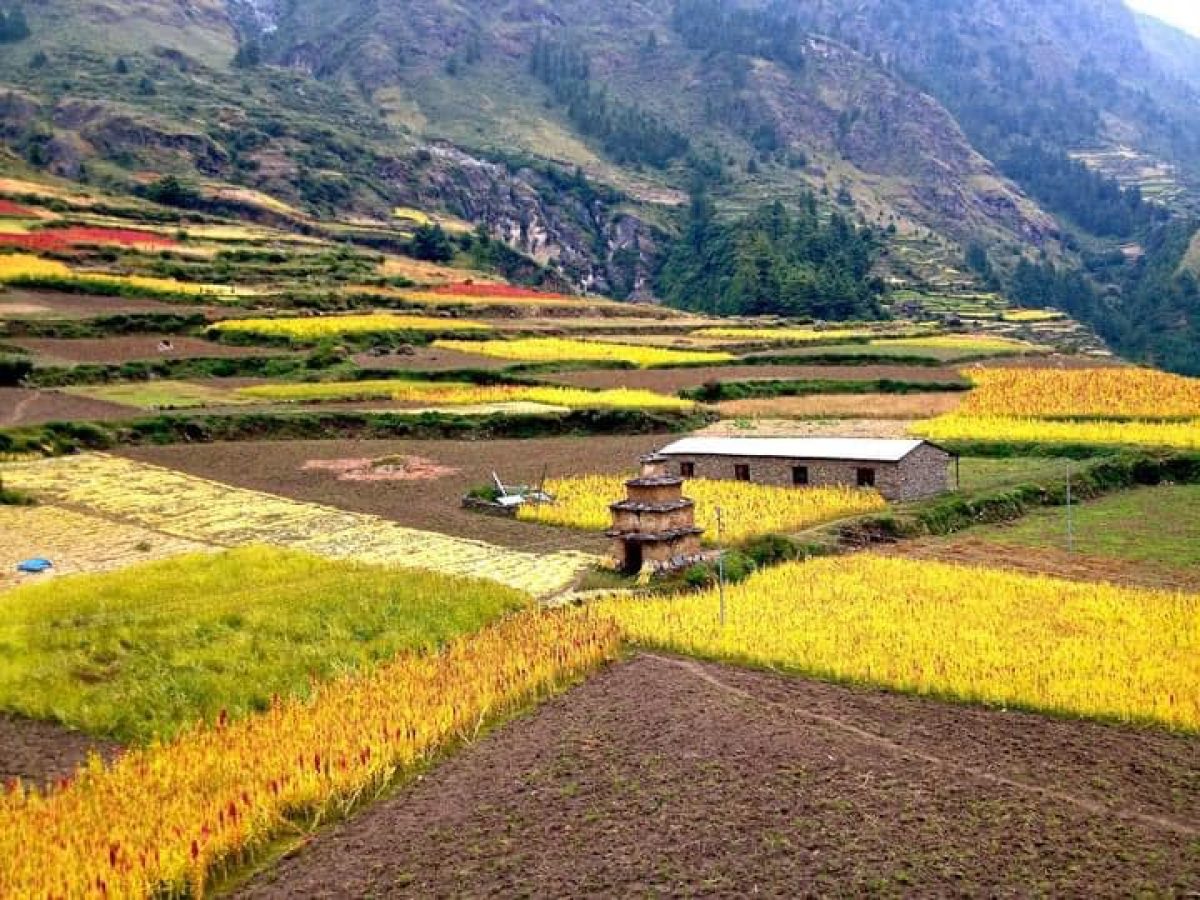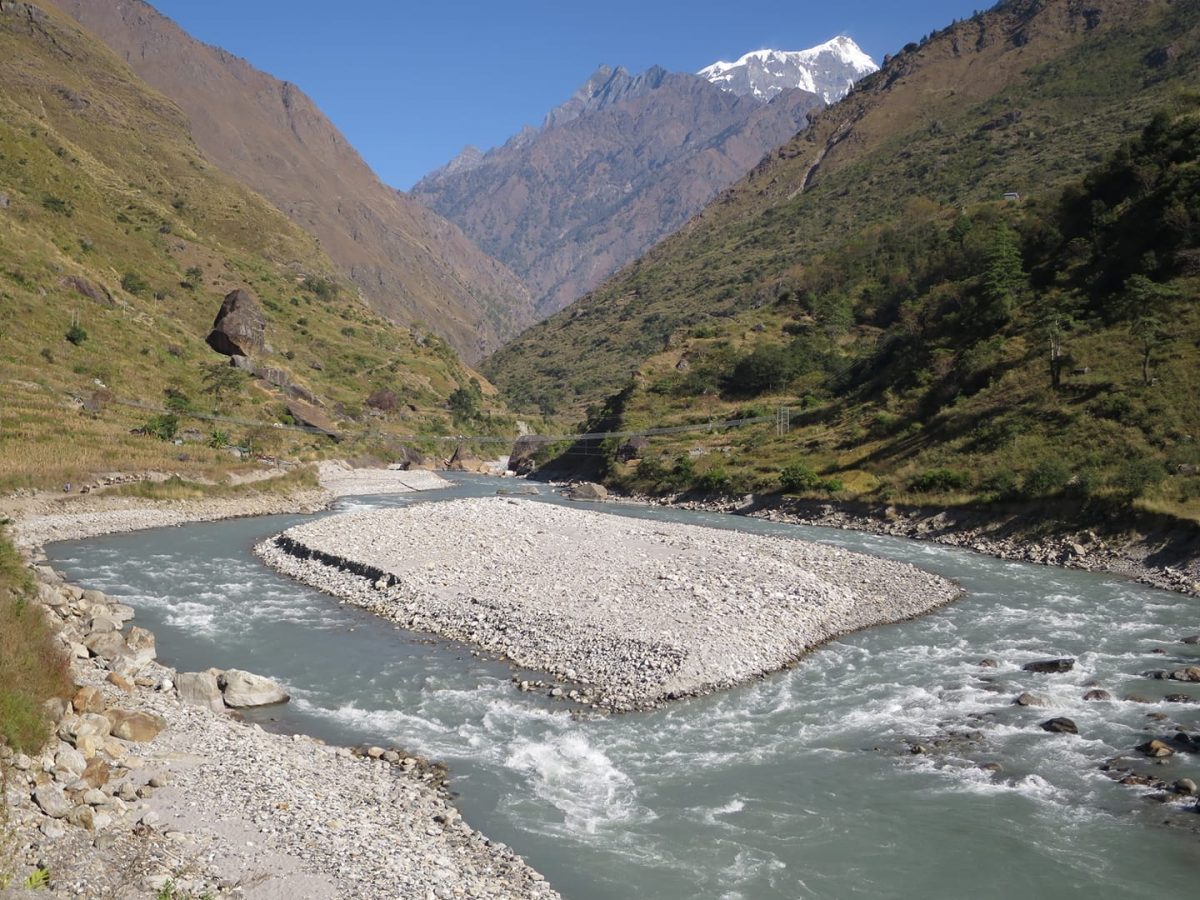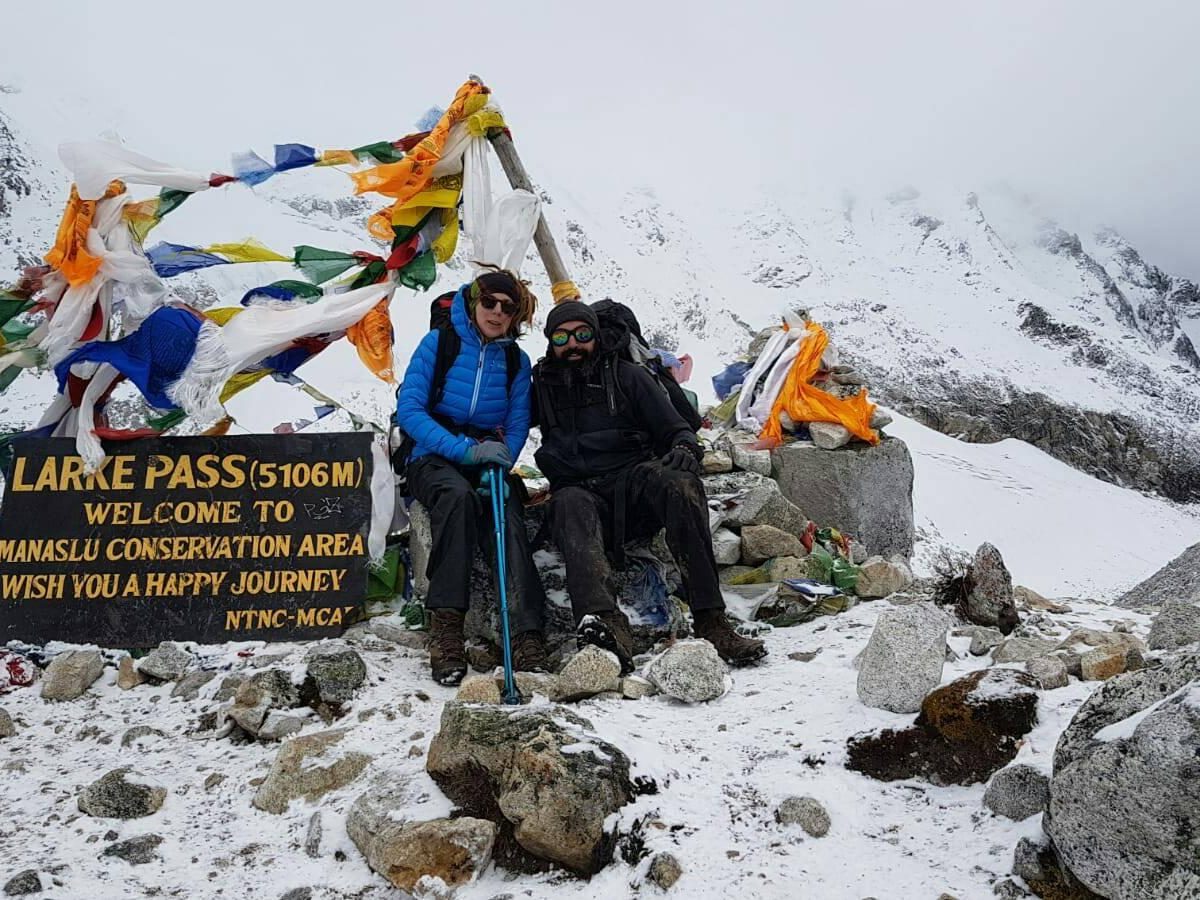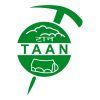Tsum Valley Manaslu Circuit Trek, an incredible 21-day journey, takes you through some of the most remote and beautiful terrains in the Himalaya in Nepal. This trek combines the wonders of the Manaslu Circuit Trek and the hidden gem of the Tsum Valley Trek, opened to trekkers in 1995 and 2008, respectively. Perfect for adventurers seeking solitude and authenticity, it offers a peaceful experience far from the busy trails of other trekking regions.
The trek weaves through stunning landscapes, from lush rhododendron and bamboo forests to steep river valleys. You’ll cross the vibrant Budhi Gandaki River several times, immersing yourself in the ever-changing scenery. On average, trekkers walk about six hours daily, enjoying the sights and sounds of nature while trekking through the Manaslu Conservation Area, home to diverse wildlife, including the elusive snow leopard.
As you climb higher, the scenery becomes more dramatic, with breathtaking views of Ganesh Himal, Sringi Himal, and the towering Mt. Manaslu. This region is a haven for trekkers looking to enjoy both nature and culture. The trail is dotted with ancient stupas, colorful chortens, and monasteries, offering glimpses into the spiritual world of Lamaism.
Tsum Valley & Manaslu Circuit Trek: How Difficult Is It?
The Tsum Valley and Manaslu Circuit Trek is considered a moderately to highly challenging trek, best suited for trekkers with good physical fitness and some previous trekking experience. The difficulty lies not just in the altitude, but also in the length of the trek (typically 18–21 days), the remote terrain, and the limited access to modern facilities. The trails often include long days of hiking, steep ascents and descents, narrow cliffside paths, and suspension bridge crossings.
One of the most demanding parts of the trek is crossing the Larkya La Pass at 5,106 meters (16,752 ft). This high-altitude crossing requires proper acclimatization and stamina, as weather conditions can be unpredictable, with strong winds, cold temperatures, and snow possible even in peak trekking seasons. Altitude sickness is also a real concern on this route, so proper pacing and rest days (especially in places like Samagaun and Samdo) are essential.
Another challenge is the remoteness of the trail. Both Tsum Valley and the upper Manaslu region are far less developed than other popular treks like Annapurna or Everest, meaning basic tea houses, limited electricity, and fewer communication options. Medical support is also minimal in remote sections, making self-reliance and a good guide or trekking agency important.
Despite the difficulty, the trek is incredibly rewarding. The solitude of Tsum Valley, rich Tibetan Buddhist culture, dramatic mountain views, and the sense of adventure make it a true off-the-beaten-path experience. With good preparation, proper gear, and the right mindset, the Tsum Valley and Manaslu Circuit Trek can be one of the most unforgettable journeys in the Himalayas.
Tsum Valley and Manaslu Circuit Trek is a unique combination that offers both cultural richness and natural grandeur. Tsum Valley, once a restricted area, is known as the “Hidden Valley of Happiness” and remains deeply rooted in Tibetan Buddhist traditions. Trekkers can witness ancient monasteries like Rachen Gompa and Mu Gompa, visit sacred sites such as Milarepa’s cave, and experience the warm hospitality of the local people who follow age-old customs. The valley’s peaceful trails, remote villages, and spiritual ambiance make it ideal for those seeking cultural immersion and tranquility.
In contrast, the Manaslu Circuit offers a more adventurous and physically challenging experience. It circles the world’s eighth-highest mountain, Mt. Manaslu (8,163m), and includes diverse landscapes—from subtropical forests and narrow gorges to alpine meadows and glacial valleys. The highlight of the circuit is crossing the Larkya La Pass (5,106m), which provides breathtaking views of peaks like Himlung Himal, Cheo Himal, and Annapurna II. With fewer crowds than the Everest and Annapurna regions, the Manaslu Circuit offers solitude and raw Himalayan beauty.
Combining both treks into a single itinerary gives trekkers a chance to explore the best of both worlds: the spiritual depth of the Tsum Valley and the dramatic high-altitude adventure of the Manaslu Circuit. The route begins with a scenic drive from Kathmandu to Machha Khola, then splits at Philim—where one branch heads toward Tsum Valley and later rejoins the main Manaslu trail. This makes it a flexible option that can be tailored to personal interests, fitness levels, and timeframes.
Whether you’re drawn by sacred Buddhist heritage or by the challenge of high mountain passes, the Tsum Valley and Manaslu Circuit Trek offers a rare and rewarding experience. It is perfect for trekkers looking to venture off the beaten path and discover some of Nepal’s most untouched and inspiring landscapes.







Welcome to Nepal!
Upon your arrival at the airport, after finishing passport, immigration, and visa procedures, our team will greet you outside the terminal holding a sign with your name. We will then take you to your hotel for some rest. The afternoon is free for you to relax.
In the evening, join us for a welcome dinner where you will meet your guide and receive an introduction to the trek along with a briefing and a check of your gear and essentials.
We warmly welcome all travelers to experience the beauty and adventure of Nepal!
After breakfast, you can begin a day of exploration within the vibrant Kathmandu Valley or simply enjoy a relaxed day at your own pace. For sightseeing, visit some of the valley’s UNESCO World Heritage Sites, such as Swayambhunath (Monkey Temple) for panoramic city views, Pashupatinath Temple, Nepal’s holiest Hindu shrine, and Boudhanath Stupa, one of the largest Buddhist stupas in the world. A trip to the Kathmandu Durbar Square will immerse you in the rich history and traditional architecture of the former royal palace complex.
Alternatively, if you prefer a slower day, take time to rest, enjoy café culture, shop for souvenirs in Thamel, or experience a traditional Nepali spa or massage. Whether you explore the city’s spiritual and historical gems or enjoy leisure time, today is a perfect opportunity to absorb the culture and energy of Kathmandu before your next adventure or departure.
After breakfast, begin your journey with a scenic drive out of Kathmandu, heading west through rolling hills and rural landscapes. The road leads to Malekhu and then to Dhading Besi, where the terrain begins to change. From here, the drive becomes bumpier as you travel along a rough, off-road track, climbing over Gola Bhanjyang with beautiful views of the Ganesh and Baudha Himal ranges.
The route continues alongside the Budhi Gandaki River, passing through traditional villages and terraced fields. After reaching Arughat, a small town at the river junction, you continue toward Soti Khola and then onward to Machha Khola. The drive takes approximately 8 to 9 hours in total and covers around 150 kilometers. Upon arrival at Machha Khola, you’ll settle in for the night, ready to begin your trek the following day.
After having breakfast in Machha Khola, the trek begins along a scenic trail following the Budhi Gandaki River. The path includes several ups and downs through forested ridges and small Gurung villages, offering beautiful views of the surrounding hills and river valleys. You’ll cross several suspension bridges, including one at Tatopani, known for its natural hot springs where trekkers often pause to relax.
Continuing onward, the trail climbs through narrow gorges and past waterfalls before reaching Dobhan, a peaceful village at the confluence of the Dobhan Khola and Budhi Gandaki. The journey takes about 6 to 7 hours and is filled with both natural beauty and cultural encounters. Dobhan has a few teahouses where you can rest and enjoy a warm meal after a rewarding day of trekking.
After having breakfast in Dobhan, the trek begins with a steady climb through lush forests and along the banks of the Budhi Gandaki River. The trail includes several suspension bridge crossings and passes through small settlements like Jagat and Salleri, where you’ll notice the influence of Tibetan culture starting to appear more strongly.
As you continue, the path becomes more scenic with views of waterfalls, terraced fields, and deep river gorges. After passing the checkpoint at Jagat, you’ll gradually ascend to the village of Philim, a relatively larger and well-organized Gurung settlement. Known for its stone-paved paths and impressive school built by a Japanese NGO, Philim offers a peaceful place to rest and prepare for the more remote sections of the trek ahead.
After enjoying a warm breakfast in Philim, you begin your trek heading north through a beautiful forested trail. The path offers gradual ascents with occasional glimpses of waterfalls and deep gorges carved by the Budhi Gandaki River. After a couple of hours, you reach Lokpa, the first village marking the entrance to the hidden Tsum Valley. The atmosphere becomes quieter and more remote as you leave the main Manaslu Circuit trail behind.
From Lokpa, the route descends steeply through dense pine and rhododendron forests, crosses a long suspension bridge, and then climbs steadily. The views become more dramatic, with the Shringi Himal beginning to appear above the valley walls. You pass chortens and mani walls that reflect the strong Tibetan Buddhist influence of the region.
After about 6 to 7 hours of total walking, you reach Chumling, a beautiful stone village nestled on the southern slopes of the Shingri Himal. Here, you’ll find ancient monasteries, fluttering prayer flags, and traditional homes. It’s a peaceful place to rest and enjoy the first real taste of Tsum Valley’s unique culture and landscape.
After breakfast in the quiet village of Chumling, you begin your ascent deeper into the sacred Tsum Valley. The trail climbs steadily, crossing a suspension bridge over the Shiar Khola and passing through dense pine and rhododendron forests. As you gain elevation, you’re rewarded with sweeping views of Ganesh Himal and surrounding peaks.
Along the way, you’ll pass several small, traditional villages and encounter mani walls, chortens, and prayer flags that reflect the strong Tibetan Buddhist culture of the region. After a final uphill push, you’ll arrive at Chhekampar, a broad, flat village nestled on a high plateau. From here, you can enjoy breathtaking mountain views and get a deeper look into the daily lives of the Tsumba people.
After enjoying breakfast in Chhekampar, you’ll begin your trek toward Nile, one of the highest permanent settlements in the Tsum Valley. The trail gradually ascends along the Shiar Khola, passing through charming villages, mani walls, and terraced fields. The landscapes become more open and dry, offering clear views of the surrounding snow-capped peaks, including the impressive Ganesh Himal range.
You’ll pass the village of Lamagaon, and if time allows, you can make a short detour to the Milarepa Cave (Piren Phu)—a sacred meditation site nestled into a cliffside. Continuing along the trail, the high-altitude air and peaceful environment add to the spiritual charm of the journey. By early afternoon, you’ll reach Nile, a quiet village where traditional stone houses and fluttering prayer flags reflect the deep-rooted Buddhist culture of the region. This is a perfect place to relax and prepare for your exploration toward Mu Gompa the next day.
After an early breakfast in Nile, you’ll begin your day with a scenic and spiritual hike toward Mu Gompa, the highest and most remote monastery in Tsum Valley. The trail gradually ascends through wide, windswept valleys surrounded by towering snow-capped peaks and dry alpine landscapes. As you approach the gompa, you’ll feel the tranquility of this sacred place, located near the Tibetan border at 3,709 meters.
Mu Gompa is a significant center of Tibetan Buddhism in the region, home to monks and a place of deep spiritual practice. You can explore the monastery, interact with the resident monks, and soak in breathtaking views of the surrounding mountains, including Ganesh Himal and the Tibetan plateau.
After spending time at Mu Gompa, you’ll retrace your steps back to Nile and continue the descent toward Chhekampar. The return trail offers a different perspective of the landscape and passes through beautiful open fields and prayer-flag-lined paths. Reaching Chhekampar in the late afternoon, you’ll enjoy the comfort of a warm meal and rest in one of the valley’s largest and most culturally rich villages.
After a nourishing breakfast in Chhekampar, you’ll begin your trek toward Lokpa. The trail descends gently through pine and rhododendron forests, passing traditional stone houses and mani walls that reflect the deep Tibetan Buddhist culture of the region. Along the way, enjoy peaceful village scenes and beautiful mountain views.
As you approach Lokpa, the gateway village to the Tsum Valley, the landscape opens up with terraced fields and a warm, welcoming atmosphere. Lokpa serves as an important stopover with teahouses and basic amenities, perfect for resting and preparing for the next stage of your journey.
After enjoying a nourishing breakfast in Lokpa, you’ll begin your trek toward Deng. The trail gently climbs through dense forests of pine and rhododendron, winding past small traditional villages and terraced fields. Along the way, you’ll cross suspension bridges and walk beside the Budhi Gandaki River, surrounded by stunning mountain scenery.
As you approach Deng, the landscape opens up to high-altitude meadows and quiet settlements with strong Tibetan cultural influences. Deng is a peaceful village with basic lodges and a welcoming atmosphere, making it an ideal place to rest and prepare for the next stage of your journey.
After a hearty breakfast in Deng, you’ll set off on today’s trek toward Namrung. The trail gradually ascends through terraced fields, traditional villages, and lush forests filled with rhododendron and pine trees. Along the way, you’ll cross suspension bridges spanning lively rivers and streams, offering beautiful views of the surrounding hills and distant snow-capped peaks.
As you climb higher, the landscape becomes more alpine, with charming stone houses and mani walls reflecting the region’s rich Tibetan Buddhist culture. Namrung is a vibrant village and an important stop on the Manaslu Circuit, offering comfortable lodges, local markets, and panoramic mountain views—a perfect place to rest and prepare for the next stage of your journey.
After a hearty breakfast, you’ll set off on the trek from Namrung to Lho. The trail gradually climbs through forests of pine and rhododendron, passing traditional stone houses and mani walls. Along the way, you’ll enjoy stunning views of the surrounding peaks, including Mt. Manaslu and Ganesh Himal.
Lho is a charming village rich in Tibetan Buddhist culture, with several important monasteries and prayer flags fluttering in the mountain breeze. This peaceful village offers a chance to rest, explore local traditions, and take in panoramic Himalayan views before continuing your journey.
After a hearty breakfast, you’ll begin your trek to the sacred Pung Gyen Gompa, perched at 4,800 meters (15,748 feet). The trail climbs steadily through alpine meadows and rugged rocky terrain, offering spectacular panoramic views of surrounding snow-capped peaks and deep valleys. This remote monastery is a spiritual sanctuary where monks continue centuries-old Tibetan Buddhist practices, providing a peaceful and reflective atmosphere for visitors.
After spending time exploring the gompa and soaking in the serene surroundings, you’ll begin your descent back to Samagaun at 3,520 meters (11,548 feet). The return trail winds through beautiful rhododendron forests and open meadows dotted with prayer flags and traditional stone houses. Samagaun, a quiet mountain village, is the perfect place to relax and recover after the day’s trek, while enjoying stunning views of the Manaslu massif and nearby peaks. This day offers both spiritual enrichment and connection with the breathtaking Himalayan environment.
After a restful breakfast in Samagaun, you’ll spend the day acclimatizing to the high altitude while exploring some of the area’s remarkable sites. One popular option is a gentle hike to Birendra Lake, a serene alpine lake surrounded by stunning mountain views. The walk to the lake is peaceful and allows your body to adjust gradually while you enjoy the crisp mountain air and beautiful scenery.
Alternatively, you can visit Pungen Monastery, an important spiritual center in the region. The monastery offers a chance to learn about Tibetan Buddhist culture, observe local rituals, and experience the calm, meditative atmosphere. For trekkers seeking a bit more adventure, a day trek to Manaslu Base Camp is possible. This route takes you closer to the towering Manaslu peak, offering breathtaking panoramic views and a taste of high-altitude trekking without the pressure of a full summit attempt. Whichever option you choose, this acclimatization day is essential for preparing your body for the challenges ahead while enriching your connection to the Manaslu region.
The trek from Samagaon to Samdo is a moderate and culturally rich journey that takes about 4 to 5 hours. As you leave Samagaon, the trail gently ascends through traditional Tibetan-style villages nestled among alpine meadows. Along the way, you’ll pass mani walls, prayer flags, and chortens, which are symbols of the region’s deep-rooted Buddhist heritage. The landscape is dotted with stone houses and monasteries, creating a serene and spiritual atmosphere that immerses you in the local culture.
The trail offers stunning views of towering peaks such as Manaslu and Shringi Himal, with the crisp mountain air enhancing the sense of peace and remoteness. Samdo, the final large settlement before the Tibetan border, is an important stop for trekkers to acclimatize and prepare for the high passes ahead. The village has cozy teahouses and basic amenities, providing a comfortable resting place amidst the rugged beauty of the Himalayas. This leg of the trek is not only a physical journey but also a deep cultural experience, bridging natural splendor and ancient traditions.
The trek from Samdo (3,860m) to Larkya Phedi, also known as Dharamshala (4,480m), is a challenging but scenic day that prepares trekkers for the demanding Larkya La Pass crossing ahead. The trail gradually ascends through rugged alpine terrain, winding alongside the Budhi Gandaki River and offering spectacular views of snow-capped peaks. Along the way, you’ll pass small settlements where local Tibetan Buddhist culture is deeply rooted, with prayer flags fluttering and mani walls lining the path.
As you approach Larkya Phedi, the landscape becomes more exposed and rocky, with a high-mountain atmosphere that signals the coming adventure. Larkya Phedi serves as a base camp and resting point for trekkers to acclimatize before the early morning ascent over Larkya La Pass. The simple lodges here offer warmth and shelter, providing a much-needed break before tackling one of the highest passes in the region. The stunning mountain vistas surrounding Dharamshala make this stop both beautiful and vital on the Manaslu Circuit Trek.
Today marks the pinnacle of our Manaslu Circuit Trek as we set out to cross the formidable Larkya La Pass. Departing from Dharamsala, also known as Larkya Phedi, the path leads us through a moraine, descending briefly to a serene lake, where we brace against the potential challenge of strong winds. The trail becomes rougher and less defined, navigating a steep, grassy slope on the south side.
Our journey continues along the moraine to a crucial edge, demarcated by two significant landmarks, guiding us toward four frozen lakes. A final, strenuous ascent from here brings us to the crest of Larkya La Pass, where the panoramic mountain vistas of Himlung Himal, Annapurna II, Mt. Kang Guru, and Cheo Himal are nothing short of breathtaking.
The descent from the pass is equally impressive, leading over the top of a moraine and veering west through a steep bed of moraine, gradually descending to a grassy moraine. The trail then winds downhill to a quaint meadow, eventually opening up to a vast meadow, dotted with small houses and mani walls, guiding us to our destination of Bhimthang, encapsulating the essence of adventure and the unparalleled beauty of the Himalayas in our journey.
The trek from Bimthang to Tiliche is a rewarding descent through beautiful and varied landscapes, taking you from high alpine meadows down into lush forests. The trail gradually drops through pine and rhododendron forests, passing traditional villages and terraced fields along the way. As you descend, the air becomes warmer and the scenery shifts to a greener, more fertile environment.
Tiliche is a peaceful village known as the gateway to the Annapurna region, offering basic lodges and warm hospitality. This section of the trek allows you to relax and enjoy the changing natural surroundings while preparing for the next stages of your journey.
After completing your trek to Dharapani, you’ll enjoy a scenic drive to Besisahar, located at 760m (2,493 ft). The journey from Dharapani to Besisahar takes you through beautiful landscapes of terraced fields, rivers, and traditional villages nestled in the foothills of the Himalayas. Besisahar serves as an important gateway town for many treks in the Annapurna and Manaslu regions, offering comfortable lodging and transport connections.
This drive marks a relaxing end to your trekking adventure, giving you a chance to unwind and reflect on the incredible journey through Nepal’s diverse mountain terrain. From Besisahar, you can continue your travels to Kathmandu or other destinations, carrying unforgettable memories of your trek.
The drive from Besisahar to Kathmandu covers approximately 180 kilometers and usually takes around 6 to 8 hours, depending on road and traffic conditions. The route winds through scenic valleys, terraced hillsides, and rural villages, offering glimpses of everyday life in Nepal’s countryside. As you approach Kathmandu Valley, the landscape gradually changes from rugged hills to more urban and suburban settings.
This drive marks the final leg of your journey, bringing you back to the bustling capital city. Kathmandu offers rich cultural experiences, historic sites, and lively markets—perfect for relaxing and exploring after your trek through the Himalayas.
Having completed the Tsum Valley Manaslu Circuit Trek, it’s time to journey onwards to your home or next adventure. Our airport team will facilitate your transfer to the international airport for your departure flight. We welcome your feedback and recommendations and commit to enhancing our services based on your insights. Safe travels!
✔️ Private pickup from Tribhuwan International Airport and drop-off at your hotel upon arrival.
✔️ Jeep ride from Kathmandu to Machha Khola.
✔️ Jeep ride from Tilche OR Dharapani to Besishar (Day 14).
✔️ Jeep rideto Kathmandu or Pokhara from Besishar (Day 14).
✔️ 3 nights in Kathmandu on a bed and breakfast (BB) basis. 4-5 Star Hotel
✔️ 20 nights in mountain teahouses (twin-sharing), including 1 night in a dormitory at Dharmasala.
✔️ 20 breakfasts,19 lunches, and 20 dinners during the trek. Meals include traditional dal bhat, noodles, momos, pasta, and soups.
✔️ Purified drinking water (Ef-Chlor water purification tablets) provided throughout the trek.
✔️ Certified, English-speaking trekking guide with first-aid training.
✔️ Assistant guide for groups of 6+ members.
✔️ All staff wages, meals, and equipment covered.
✔️ Required trekking permits for the Manaslu and Tsum Valley region.
✔️ All applicable taxes, service charges, and VAT.
✔️ Porter for Luggage Carrying: (each porter can carry up to 25 kg; one porter for two trekkers is recommended).
✔️ All staff wages, meals, and equipment are covered.
✔️ Complimentary Manaslu and Tsum Valley trekking map.
✔️ Sleeping bag rated up to -20°C.
✔️ Duffel bag (70–80L) if using porter service.
✔️ First-aid medical kit carried by your guide.
✔️ Free luggage storage during the trek.
✔️ Completion certificate.
✔️ Nature Heaven Treks souvenir T-shirt.
✔️ Farewell dinner in Kathmandu after the trek.
❌ International flights, Nepal visa fees, and personal travel insurance are not included.
❌ Extra costs during the trek, such as hot showers, Wi-Fi, drinks, extra meals, and battery charging.
❌ Any additional nights or meals in Kathmandu beyond what’s included in the package.
❌ Tips for your guide and porter (customary but not mandatory).
❌ Any services not specifically mentioned under “Included in the Cost.”
Enjoy complete flexibility with private departures available year-round. You can choose your preferred start date, and we’ll handle all the arrangements. Just use the booking form on the top right to select your date and leave the rest to us.
Once you book, your trip is 100% guaranteed – even if you’re the only one. We don’t cancel based on low enrollment. Every trekker receives the same high-quality service, whether solo or in a small group.
If your plans change, you have options. Cancel at least 30 days before departure for a full deposit refund. If canceling within 30 days, your deposit stays safe with us and can be used to reschedule your trek for any future date that suits you.
The best times to trek the Manaslu and Tsum Valley Circuit are spring (March to May) and autumn (September to November). During spring, the trail offers clear mountain views, pleasant temperatures, and blooming rhododendrons in multiple colors. Autumn brings stable weather, clear skies, and exceptional views of Mt. Manaslu and surrounding peaks.
Trekking in winter and monsoon seasons is not advised due to heavy snowfall, closed lodges at higher altitudes, and high landslide risks during the rains.
Although food choices are limited compared to city areas, trekkers can expect healthy, hygienic meals throughout the journey. A typical trek includes 21 breakfasts, 19 lunches, and 20 dinners.
Breakfast options include Tibetan bread, eggs, cereals, pancakes, toast, fruits, and hot drinks.
Lunch and dinner commonly feature dal bhat, vegetable curries, noodles, thukpa, pasta, soups, and snacks. It’s best to eat fresh vegetables, drink plenty of water, and avoid mixing dairy, meat, alcohol, and coffee.
In Kathmandu, you’ll find a wide range of hotels, but along the trek, accommodation is mostly at basic tea houses. Rooms are twin-sharing, often with shared toilets outside the room. Tea houses have a communal dining area with a fireplace. In higher altitudes, it’s essential to carry a warm sleeping bag.
Tsum Valley with Manaslu Trek is considered a moderately challenging adventure suitable for trekkers with a good level of fitness and some prior trekking experience. While the Tsum Valley section features gentler trails through forests and villages with gradual altitude gains, the Manaslu Circuit adds more physical demands, especially when crossing the high Larkya La Pass at 5,106 meters. Trekkers should be prepared for long hiking days, variable terrain, and the effects of high altitude.
Despite its challenges, this trek rewards adventurers with stunning landscapes, rich cultural encounters, and fewer crowds compared to more popular routes. Proper acclimatization and a steady pace are essential to manage altitude sickness risks, making it a fulfilling journey for those seeking both spiritual immersion and high-mountain adventure in one of Nepal’s most beautiful regions.
Travel insurance is mandatory. It must include emergency evacuation and medical expenses, especially for high-altitude treks. Nature Heaven Treks Nepal recommends confirming that your insurer covers adventure activities and trip cancellations.
Symptoms can start at elevations above 3,500m and include nausea, headaches, dizziness, and fatigue.
Tips to prevent altitude sickness:
Ascend gradually and allow time for acclimatization
Stay hydrated and avoid alcohol
Consider taking Acetazolamide (Diamox) after consulting a doctor
Descend immediately if symptoms worsen
Rest, use portable oxygen if needed, and never ignore warning signs
Essentials include:
50–70L backpack, sleeping bag, headlamp
Water bottle/purifier, warm clothes, rain gear
Hiking boots, gloves, sunglasses, sunscreen
Quick-dry layers, thermal wear, first aid kit, toiletries
Personal documents, passport, camera, maps, and guidebook
Your safety is a top priority.Nature Heaven Treks Nepal’s trained guides carry first aid kits and are equipped to handle emergencies. In case of altitude issues, your trek leader will decide whether to proceed or descend. Emergency helicopter rescue is available if required. The team ensures you trek in a group for added safety.
Nature Heaven Treks is a certified and experienced trekking agency. To book your trek, a 10% deposit is required. You’ll need to provide a copy of your passport, insurance, passport-size photos, and flight details within a week of booking. Payments can be made via online transfer, Western Union, or in person using cash, card, or bank transfer upon arrival in Nepal.
Our team is here to guide you with personalized recommendations, insider advice, and the latest travel updates to make your journey smooth and memorable.
Embark on unforgettable adventures through majestic landscapes, rich cultural sites, and serene natural retreats. Our travel packages are designed to suit every explorer whether you seek thrill, peace, or heritage.
More than 730 individuals and over 50 countries travellers we have deal with
Yael0505
July 21, 2024
“We had an excellent trek with Krishna and his excellent team. The tour itself was excellently planned.”
Wildnature2006,
May 1, 2024
“From the moment we met Krishna at the airport, we knew we were in good hands. Immediately upon arrival…”
Dreamer47485971266,
November 23, 2023
“We had a wonderful time trekking Langtang and the frozen lakes. Krishna has done everything so every…”
Tsum Valley Manaslu Circuit Trek is moderately to highly challenging. It involves long walking days, high altitudes (up to 5,106m), and rough terrain. Proper acclimatization, physical fitness, and some trekking experience are recommended for a safe and enjoyable journey.
On average, you walk 5 to 7 hours per day during the Tsum Valley and Manaslu Circuit Trek. Some days may be shorter or longer depending on altitude, terrain, and acclimatization needs.
Why Nature Heaven Treks and Expedition
Nature Heaven Treks offers a variety of trekking options, including popular routes like the Everest Base Camp and Annapurna Circuit, as well as off-the-beaten-path adventures in regions like Manaslu and Langtang .
✅ 10+ Years of Trekking Experience
✅ Certified and Friendly Local Guides
✅ 100% Tailor-Made Itineraries
✅ Small Groups, Big Adventures
✅ Eco-Conscious and Culturally Respectful Practices
✅ 5-Star Reviews from Adventurers Worldwide






@Copyright 2025 Nature Heaven Treks and Expedition, Kathmandu, Nepal. All Rights Reserved.
Chat with Us